Spatio-Temporal Impact of Global Migration on Carbon Transfers Based on Complex Network and Stepwise Regression Analysis
Abstract
:1. Introduction
- First, based on gravity concept and two-layer network method, we investigate the structural similarity between the global migration network and the carbon transfer network.
- Second, we use the STIRPAT framework to analyze the impact of migration on embodied carbon transfers.
- Third, we discuss the implications of heteroscedastic impacts induced by gender, income levels, and product composition.
2. Methodology and Data
2.1. Two-Layer Network and Dissimilarity Metric
2.2. Environmental Impact of Migration: A STIRPAT Model
2.3. Data Source
3. Empirical Results
3.1. Center-of-Gravity Movement and Comparison
3.2. Inter-Layer Network Dissimilarity Analysis Based Nodes
3.3. Inter-Layer Network Similarity Analysis Based Links
3.4. Regression Results of Migration’s Effect on Carbon Transfers
4. Discussions
4.1. Impact of Sex-Specific Migration
4.2. The Heteroscedasticity of Migration’s Affect across Income Levels
5. Conclusions and Implications
Author Contributions
Funding
Institutional Review Board Statement
Informed Consent Statement
Data Availability Statement
Acknowledgments
Conflicts of Interest
Appendix A
| Country | Abbreviation | Region | Country | Abbreviation | Region |
|---|---|---|---|---|---|
| 42 High income economics (HIEs) | |||||
| Australia | AUS | East Asia and the Pacific | Austria | AUT | Europe and Central Asia |
| Brunei Darussalam | BRN | Belgium | BEL | ||
| Hong Kong, China | HKG | Croatia | HRV | ||
| Japan | JPN | Cyprus | CYP | ||
| New Zealand | NZL | Denmark | DNK | ||
| Singapore | SGP | Estonia | EST | ||
| Canada | CAN | North America | Finland | FIN | |
| Israel | ISR | Middle East and North Africa | France | FRA | |
| United States | USA | Slovakia | SVK | ||
| Republic of Korea | KOR | TaiPei, China | TWN | ||
| Malta | MLT | Germany | DEU | ||
| Saudi Arabia | SAU | Greece | GRC | ||
| Norway | NOR | Europe and Central Asia | Hungary | HUN | |
| Poland | POL | Iceland | ISL | ||
| Portugal | PRT | Ireland | IRL | ||
| Slovenia | SVN | Italy | ITA | ||
| Spain | ESP | Latvia | LVA | ||
| Sweden | SWE | Lithuania | LTU | ||
| Switzerland | CHE | Luxembourg | LUX | ||
| United Kingdom | GBR | Netherlands | NLD | ||
| Czechia | CZE | ||||
| Chile | CHL | Latin America and the Caribbean | |||
| 15 Upper middle income economies (UMEs) | |||||
| Argentina | ARG | Latin America and the Caribbean | China | CHN | East Asia and the Pacific |
| Brazil | BRA | Malaysia | MYS | ||
| Colombia | COL | Thailand | THA | ||
| Costa Rica | CRI | Bulgaria | BGR | Europe and Central Asia | |
| Mexico | MEX | Kazakhstan | KAZ | ||
| Peru | PER | Romania | ROU | ||
| South Africa | ZAF | Sub-saharan Africa | Turkey | TUR | |
| Russia | RUS | Europe and Central Asia | |||
| 7 Low and lower middle income economies (LMEs) | |||||
| Indonesia | IDN | East Asia and the Pacific | India | IND | South Asia |
| Cambodia | KHM | Morocco | MAR | Middle East and North Africa | |
| Philippines | PHL | Tunisia | TUN | ||
| Viet Nam | VNM | ||||
| Types of Variables | Variables | Definitions |
|---|---|---|
| Explained variable | Carbon emission transfers (CT) | Embodied carbon emissions flows |
| Explanatory variables | Population scale (POP) | Total population size |
| Economic development level (rGDP) | GDP/total population | |
| Population migration (PM) | Migration flows | |
| Control variable | Technical progress (FDI) | Foreign direct investment |
References
- Gazzotti, P.; Emmerling, J.; Marangoni, G.; Castelletti, A.; Wijst, K.V.D.; Hof, A.; Tavoni, M. Persistent inequality in economically optimal climate policies. Nat. Commun. 2021, 12, 3421. [Google Scholar] [CrossRef] [PubMed]
- United Nations Climate Change. Available online: https://unfccc.int/ (accessed on 20 March 2020).
- Zhang, C.; Zhou, X. Does foreign direct investment lead to lower CO2 emissions? Evidence from a regional analysis in China. Renew. Sustain. Energy Rev. 2016, 58, 943–951. [Google Scholar] [CrossRef]
- Wang, M.; Feng, C. Decomposition of energy-related CO2 emissions in China: An empirical analysis based on provincial panel data of three sectors. Appl. Energy 2017, 190, 772–787. [Google Scholar] [CrossRef]
- Lv, Y.; Chen, W.; Cheng, J. Modelling dynamic impacts of urbanization on disaggregated energy consumption in China: A spatial Durbin modelling and decomposition approach. Energy Policy 2019, 133, 110841. [Google Scholar] [CrossRef]
- Abeydeera, L.H.U.W.; Mesthrige, J.W.; Samarasinghalage, T.I. Global Research on Carbon Emissions: A Scientometric Review. Sustainability 2019, 11, 3972. [Google Scholar] [CrossRef] [Green Version]
- Ehrlich, P.R.; Holdren, J.P. Impact of population growth. Science 1971, 171, 1212–1217. [Google Scholar] [CrossRef]
- Kaya, Y. Impact of Carbon Dioxide Emission Control on GNP Growth: Interpretation of Proposed Scenarios [R]. Presented at the Energy and Industry Subgroup, Response Strategies Working Group, International Panel on Climate Change, Paris, France; 1990. Available online: https://archive.ipcc.ch/publications_and_data/publications_ipcc_first_assessment_1990_wg3.shtml (accessed on 20 March 2020).
- Wang, Y.; Zhao, H.; Li, L.; Liu, Z.; Liang, S. Carbon dioxide emission drivers for a typical metropolis using input–output structural decomposition analysis. Energy Policy 2013, 58, 312–318. [Google Scholar] [CrossRef]
- Fang, D.; Yang, J. Drivers and critical supply chain paths of black carbon emission: A structural path decomposition. J. Environ. Manag. 2021, 278, 111514. [Google Scholar] [CrossRef] [PubMed]
- Zhang, X.; Li, Z.; Ma, L.; Chong, C.; Ni, W. Analyzing Carbon Emissions Embodied in Construction Services: A Dynamic Hybrid Input–Output Model with Structural Decomposition Analysis. Energies 2019, 12, 1456. [Google Scholar] [CrossRef] [Green Version]
- Dong, F.; Yu, B.; Hadachin, T.; Dai, Y.; Wang, Y.; Zhang, S.; Long, R. Drivers of carbon emission intensity change in China. Resour. Conserv. Recycl. 2018, 129, 187–201. [Google Scholar] [CrossRef]
- Yu, B.; Wei, Y.M.; Kei, G.; Matsuoka, Y. Future scenarios for energy consumption and carbon emissions due to demographic transitions in Chinese households. Nat. Energy 2018, 3, 109–118. [Google Scholar] [CrossRef]
- Hauer, M.E. Migration induced by sea-level rise could reshape the US population landscape. Nat. Clim. Chang. 2017, 7, 321–325. [Google Scholar] [CrossRef] [Green Version]
- Black, R.; Adger, W.N.; Arnell, N.W.; Dercon, S.; Geddes, A.; Thomas, D. The effect of environmental change on human migration. Glob. Environ. Chang. 2011, 21, S3–S11. [Google Scholar] [CrossRef]
- Stephenson, J.; Newman, K.; Mayhew, S. Population dynamics and climate change: What are the links? J. Public Health 2010, 32, 150–156. [Google Scholar] [CrossRef] [PubMed]
- Sun, Y.; Zhang, X.; Ding, Y.; Chen, D.; Qin, D.; Zhai, P. Understanding human influence on climate change in China. Natl. Sci. Rev. 2021, nwab113. [Google Scholar] [CrossRef]
- Huwart, J.Y.; Verdier, L. Economic Globalisation: Origins and Consequences [D]; OECD Insights; OECD Publishing: Paris, France, 2013; ISBN 9789264111899. [Google Scholar]
- Sgrignoli, P.; Metulini, R.; Schiavo, S.; Riccaboni, M. The relation between global migration and trade networks. Phys. A Stat. Mech. Appl. 2015, 417, 245–260. [Google Scholar] [CrossRef] [Green Version]
- Li, Q.; Chen, H. The Relationship between Human Well-Being and Carbon Emissions. Sustainability 2021, 13, 547. [Google Scholar] [CrossRef]
- Lebel, L.; Garden, P.; Banaticla, M.R.N.; Lasco, R.D.; Contreras, A.; Mitra, A.P.; Sharma, C.; Nguyen, H.T.; Ooi, G.L.; Sari, A. Integrating carbon mangement into thedevelopment strategies of urbanizing regions in Asia. J. Ind. Ecol. 2007, 11, 61–81. [Google Scholar] [CrossRef] [Green Version]
- Noja, G.G.; Cristea, S.M.; Yüksel, A.; Pânzaru, C.; Drăcea, R.M. Migrants’ Role in Enhancing the Economic Development of Host Countries: Empirical Evidence from Europe. Sustainability 2018, 10, 894. [Google Scholar] [CrossRef] [Green Version]
- Gao, C.; Tao, S.; He, Y.; Su, B.; Sun, M.; Mensah, I.A. Effect of population migration on spatial carbon emission transfers in China. Energy Policy 2021, 156, 112450. [Google Scholar] [CrossRef]
- Shi, G.; Lu, X.; Deng, Y.; Urpelainen, J.; Liu, L.C.; Zhang, Z.; Wei, W.; Wang, H. Air Pollutant Emissions Induced by Population Migration in China. Environ. Sci. Technol. 2020, 54, 6308–6318. [Google Scholar] [CrossRef]
- Benveniste, H.; Oppenheimer, M.; Fleurbaey, M. Effect of border policy on exposure and vulnerability to climate change. Proc. Natl. Acad. Sci. USA 2020, 117, 26692–26702. [Google Scholar] [CrossRef] [PubMed]
- Liu, B.; Zhao, Q.; Jin, Y.; Shen, J.; Li, C. Application of combined model of stepwise regression analysis and artificial neural network in data calibration of miniature air quality detector. Sci. Rep. 2021, 11, 3247. [Google Scholar] [CrossRef]
- Schieber, T.A.; Carpi, L.; Díaz-Guilera, A.; Pardalos, P.M.; Masoller, C.; Ravetti, M.G. Quantifcation of network structural dissimilarities. Nat. Commun. 2017, 8, 13928. [Google Scholar] [CrossRef] [Green Version]
- Jiang, Y.; Li, M.; Fan, Y.; Di, Z. Characterizing dissimilarity of weighted networks. Sci. Rep. 2021, 11, 5768. [Google Scholar] [CrossRef]
- Zhang, X.; Cui, H.; Zhu, J.; Du, Y.; Wang, Q.; Shi, W. Measuring the dissimilarity of multiplex networks: An empirical study of international trade networks. Phys. A Stat. Mech. Appl. 2017, 467, 380–394. [Google Scholar] [CrossRef]
- Dietz, T.; Rosa, E.A. Effects of population and affluence on CO2 emissions. Proc. Natl. Acad. Sci. USA 1997, 94, 175–179. [Google Scholar] [CrossRef] [PubMed] [Green Version]
- Lin, S.; Zhao, D.; Marinova, D. Analysis of the environmental impact of China based on STIRPAT model. Environ. Impact Assess. Rev. 2009, 29, 341–347. [Google Scholar] [CrossRef]
- Li, H.; Mu, H.; Zhang, M.; Li, N. Analysis on influence factors of China’s CO2 emissions based on Path-STIRPAT model. Energy Policy 2011, 39, 6906–6911. [Google Scholar] [CrossRef]
- Shahbaz, M.; Loganathan, N.; Muzaffar, A.T.; Ahmed, K.; Jabran, M.A. How urbanization affects CO2 emissions in Malaysia? The application of STIRPAT model. Renew. Sustain. Energy Rev. 2016, 57, 83–93. [Google Scholar] [CrossRef] [Green Version]
- Ulucak, R.; Erdogan, F.; Bostanci, S.H. A STIRPAT-based investigation on the role of economic growth, urbanization, and energy consumption in shaping a sustainable environment in the Mediterranean region. Environ. Sci. Pollut. Res. 2021, 28, 55290–55301. [Google Scholar] [CrossRef] [PubMed]
- Hastie, T.; Tibshirani, R.; Friedman, J. The Elements of Statistical Learning: Data Mining, Inference, and Prediction, 2nd ed.; Springer: New York, NY, USA, 2009. [Google Scholar]
- Honjo, K.; Gomi, K.; Kanamori, Y.; Takahashi, K.; Matsuhashi, K. Long-term projections of economic growth in the 47 prefectures of Japan: An application of Japan shared socioeconomic pathways. Heliyon 2021, 7, e06412. [Google Scholar] [CrossRef]
- Hyndman, R.J.; Athanasopoulos, G. Forecasting: Principles and Practice, 2nd ed.; OTexts: Melbourne, Australia, 2018. [Google Scholar]
- Honjo, K.; Shiraki, H.; Ashina, S. Dynamic linear modeling of monthly electricity demand in Japan: Time variation of electricity conservation effect. PLoS ONE 2018, 13, e0196331. [Google Scholar] [CrossRef] [Green Version]
- Carbon Dioxide Emissions Embodied in International Trade (2019 ed.). Organization for Economic Cooperation and Development Web Site. 2019. Available online: https://stats.oecd.org/Index.aspx?DataSetCode=IOTSI4_2018 (accessed on 20 March 2020).
- United Nations, Department of Economic and Social Affairs, Population Division Web Site. Available online: https://www.un.org/development/desa/pd/ (accessed on 20 March 2020).
- The World Bank Home Page. Available online: https://www.worldbank.org/en/home (accessed on 20 March 2020).
- Zhang, Y.; Zhang, J.; Yang, Z.; Li, J. Analysis of the distribution and evolution of energy supply and demand centers of gravity in China. Energy Policy 2012, 49, 695–706. [Google Scholar] [CrossRef]
- Li, Z.; Jiang, W.; Wang, W.; Lei, X.; Deng, Y. Exploring spatial-temporal change and gravity center movement of construction land in the Chang-Zhu-Tan urban agglomeration. J. Geogr. Sci. 2019, 29, 1363–1380. [Google Scholar] [CrossRef] [Green Version]
- Gou, W.; Huang, S.; Chen, Q.; Chen, J.; Li, X. Structure and Dynamic of Global Population Migration Network. Complexity 2020, 2020, 4359023. [Google Scholar] [CrossRef]
- Sun, L.; Qin, L.; Taghizadeh-Hesary, F.; Zhang, J.; Mohsin, M.; Chaudhry, I.S. Analyzing carbon emission transfer network structure among provinces in China: New evidence from social network analysis. Environ. Sci. Pollut. Res. 2020, 27, 23281–23300. [Google Scholar] [CrossRef]
- Gao, C.; Sun, M.; Shen, B. Features and evolution of international fossil energy trade relationships: A weighted multilayer network analysis. Appl. Energy 2015, 156, 542–554. [Google Scholar] [CrossRef]
- Gao, C.; Su, B.; Sun, M.; Zhang, X.; Zhang, Z. Interprovincial transfer of embodied primary energy in China: A complex network approach. Appl. Energy 2018, 215, 792–807. [Google Scholar] [CrossRef]
- Huang, L.; Zhao, X. Impact of financial development on trade-embodied carbon dioxide emissions: Evidence from 30 provinces in China. J. Clean. Prod. 2018, 198, 721–736. [Google Scholar] [CrossRef]
- Wright, K.; Black, R. International migration and the downturn: Assessing the impacts of the global financial downturn on migration, poverty and human well-being. J. Int. Dev. 2011, 23, 555–564. [Google Scholar] [CrossRef]


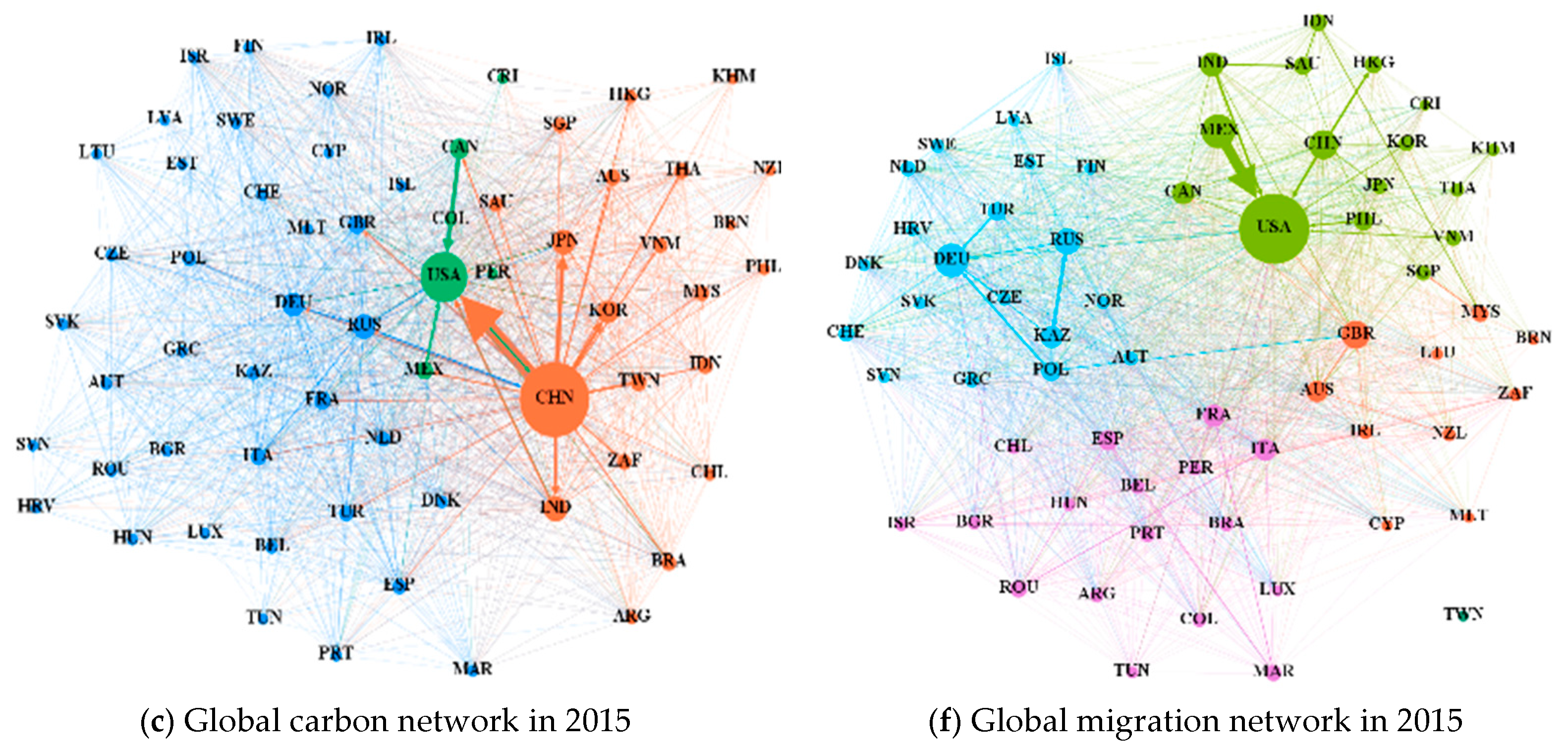
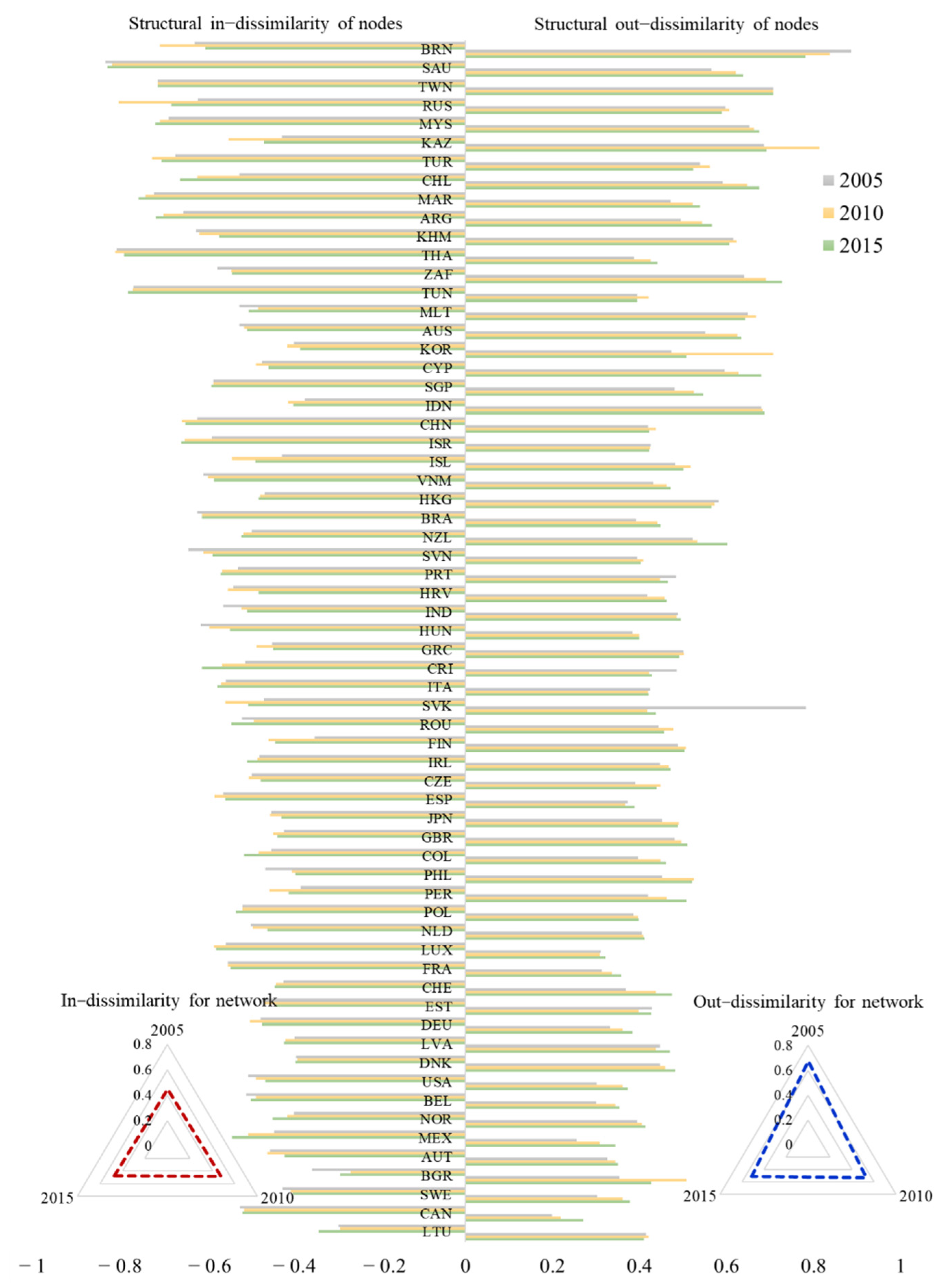
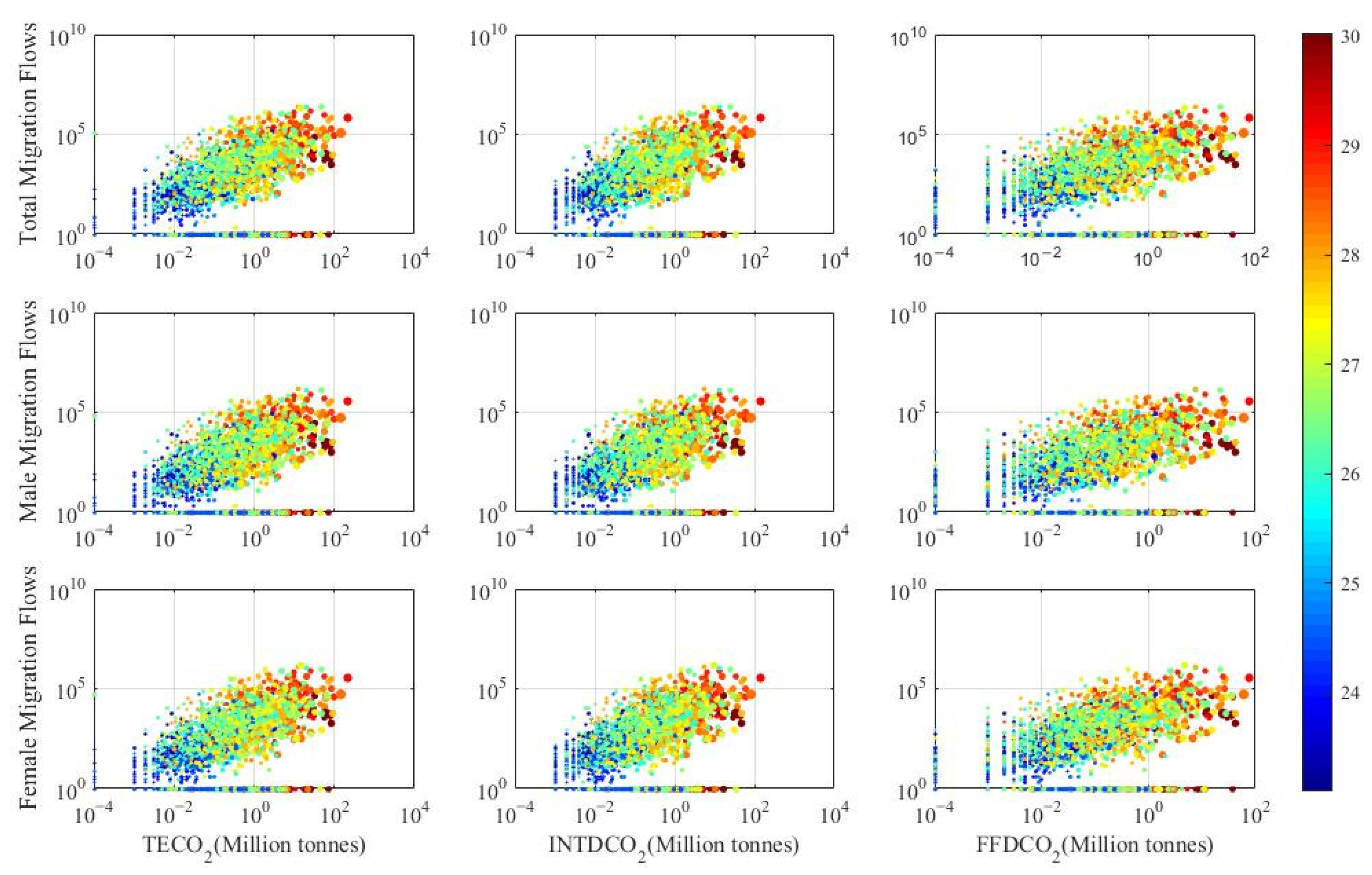
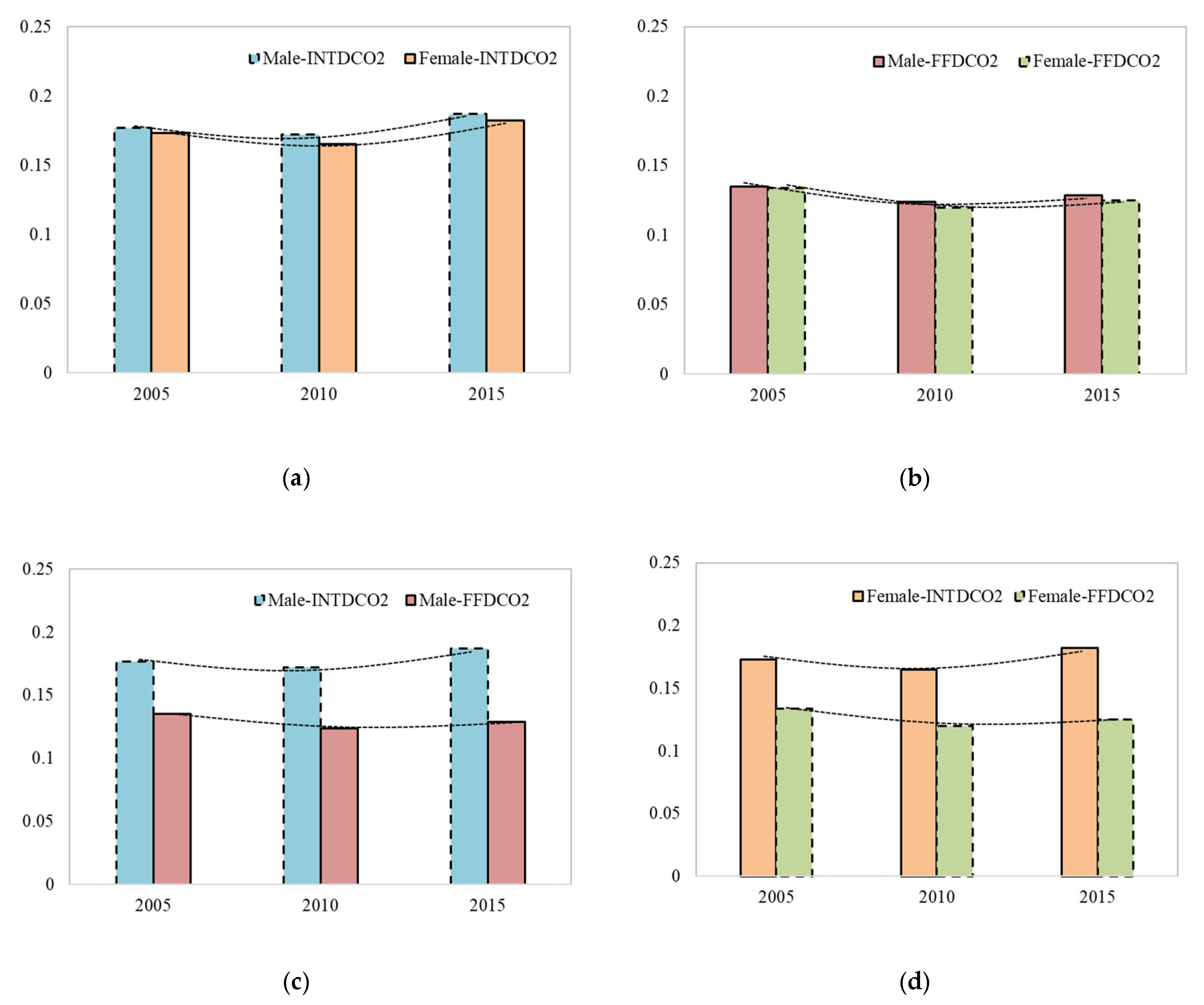
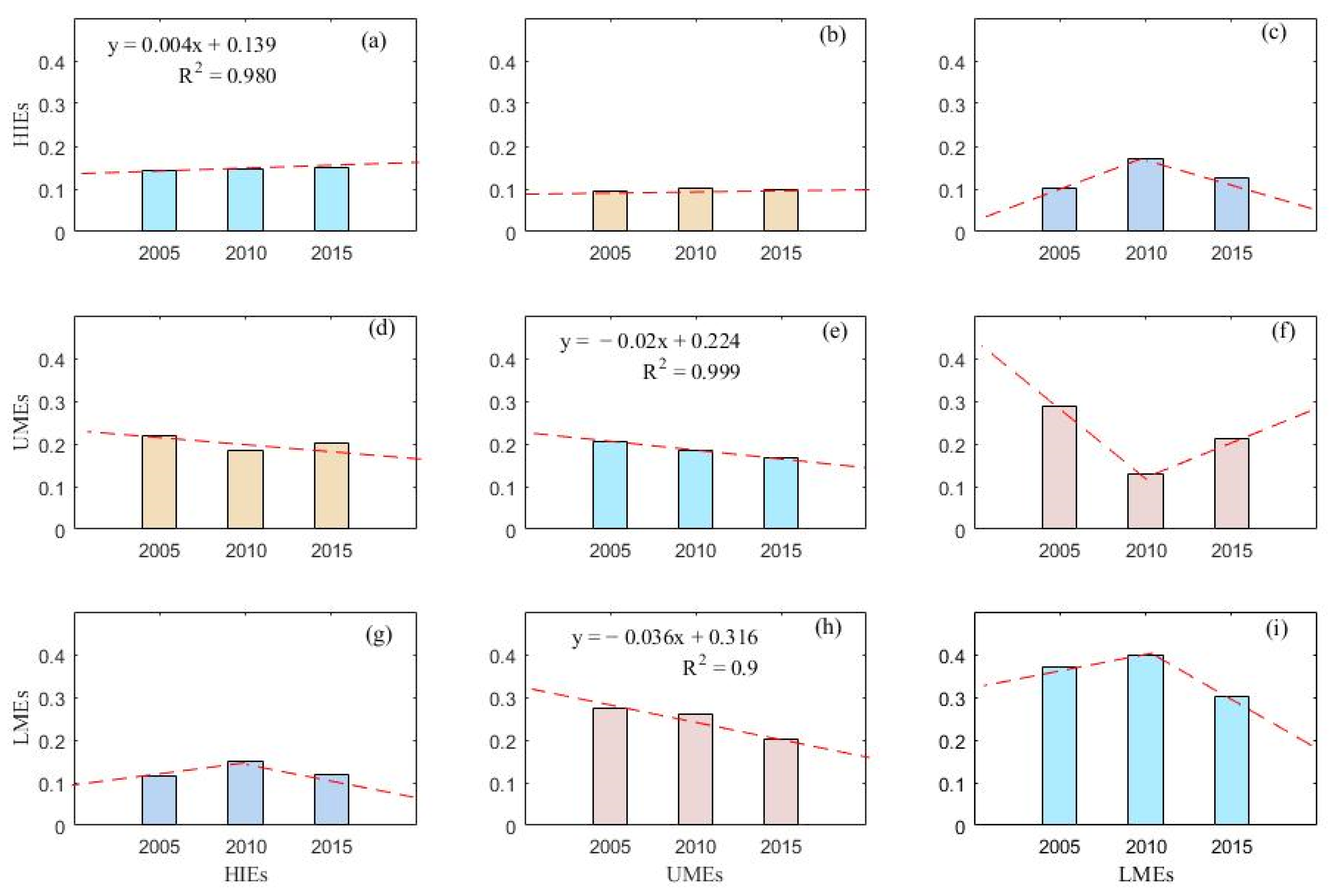
| Variables | Model 1 | Model 2 | Model 3 |
|---|---|---|---|
| ε | −48.671 *** | −46.321 *** | −45.410 *** |
| ln(Pmi→j) | 0.123 *** | 0.121 *** | 0.118 *** |
| ln(POPi) | 0.916 *** | 0.756 *** | 0.758 *** |
| ln(POPj) | 0.853 *** | 0.854 *** | 0.789 *** |
| ln(rGDPi) | 0.872 *** | 0.607 *** | 0.607 *** |
| ln(rGDPj) | 0.872 *** | 0.876 *** | 0.770 *** |
| ln(FDIi) | 0.252 *** | 0.254 *** | |
| ln(FDIj) | 0.105 *** | ||
| R2-adjusted | 0.687 | 0.691 | 0.692 |
| AIC | 3.698 | 3.685 | 3.683 |
| Variables | Model 1 | Model 2 | Model 3 |
|---|---|---|---|
| ε | −47.597 *** | −45.923 *** | −45.494 *** |
| ln(Pmi→j) | 0.120 *** | 0.119 *** | 0.118 *** |
| ln(POPi) | 0.876 *** | 0.741 *** | 0.741 *** |
| ln(POPj) | 0.887 *** | 0.888 *** | 0.852 ** |
| ln(rGDPi) | 0.795 *** | 0.568 *** | 0.567 *** |
| ln(rGDPj) | 0.835 *** | 0.838 *** | 0.779 *** |
| ln(FDIi) | 0.231 *** | 0.232 *** | |
| ln(FDIj) | 0.062 ** | ||
| R2-adjusted | 0.701 | 0.705 | 0.705 |
| AIC | 3.594 | 3.579 | 3.579 |
| Variables | Model 1 | Model 2 | Model 3 |
|---|---|---|---|
| ε | −47.232 *** | −46.707 *** | −46.405 *** |
| ln(Pmi→j) | 0.125 *** | 0.125 *** | 0.124 *** |
| ln(POPi) | 0.887 *** | 0.845 *** | 0.845 *** |
| ln(POPj) | 0.889 *** | 0.889 *** | 0.865 *** |
| ln(rGDPi) | 0.764 *** | 0.693 *** | 0.692 *** |
| ln(rGDPj) | 0.777 *** | 0.777 *** | 0.737 *** |
| ln(FDIi) | 0.072 *** | 0.073 *** | |
| ln(FDIj) | 0.042 | ||
| R2-adjusted | 0.710 | 0.710 | 0.711 |
| AIC | 3.558 | 3.557 | 3.557 |
Publisher’s Note: MDPI stays neutral with regard to jurisdictional claims in published maps and institutional affiliations. |
© 2022 by the authors. Licensee MDPI, Basel, Switzerland. This article is an open access article distributed under the terms and conditions of the Creative Commons Attribution (CC BY) license (https://creativecommons.org/licenses/by/4.0/).
Share and Cite
Gao, C.; Zhong, Y.; Mensah, I.A.; Tao, S.; He, Y. Spatio-Temporal Impact of Global Migration on Carbon Transfers Based on Complex Network and Stepwise Regression Analysis. Sustainability 2022, 14, 844. https://doi.org/10.3390/su14020844
Gao C, Zhong Y, Mensah IA, Tao S, He Y. Spatio-Temporal Impact of Global Migration on Carbon Transfers Based on Complex Network and Stepwise Regression Analysis. Sustainability. 2022; 14(2):844. https://doi.org/10.3390/su14020844
Chicago/Turabian StyleGao, Cuixia, Ying Zhong, Isaac Adjei Mensah, Simin Tao, and Yuyang He. 2022. "Spatio-Temporal Impact of Global Migration on Carbon Transfers Based on Complex Network and Stepwise Regression Analysis" Sustainability 14, no. 2: 844. https://doi.org/10.3390/su14020844
APA StyleGao, C., Zhong, Y., Mensah, I. A., Tao, S., & He, Y. (2022). Spatio-Temporal Impact of Global Migration on Carbon Transfers Based on Complex Network and Stepwise Regression Analysis. Sustainability, 14(2), 844. https://doi.org/10.3390/su14020844







